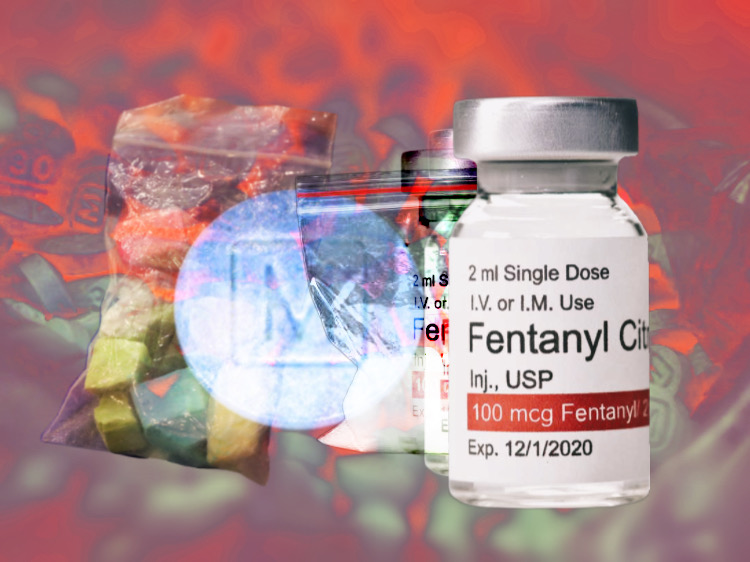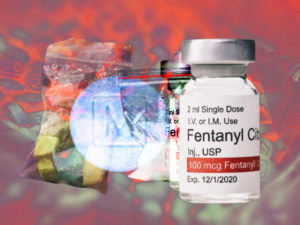Cheap, potent, deadly: Fentanyl flood raises campus risks
September 21, 2022
The poison keeps spreading.
The drug fentanyl is flooding the country, posing a deadly threat as law enforcement agencies struggle to contain it.
“It’s very potent and very, very deadly,” Michael Arnett, an assistant special agent in charge at the New Orleans division of the Drug Enforcement Administration, said.
“The risk could be anywhere,” Dana Wilkosz, who teaches opioid survival at the New Orleans Health Department, said.
Fifty times stronger than heroin and a hundred times stronger than morphine, fentanyl is a synthetic drug at the heart of the country’s decades-old opioid crisis. It can kill with the amount that would fit on the tip of a pencil. And it is poisoning some drug users before they even know what they have swallowed.
It happened at Ohio State University, officials said — two students, dead after taking counterfeit adderall contaminated with fentanyl last May.
It happened to Ciaya Whetstone, a University of New Orleans student celebrating Mardi Gras in February. An accidental overdose — fentanyl and alcohol.
“You can’t even tell the difference,” Arnett said, between a real pill and one that contains the deadly synthetic agent.
Last year, Tulane Emergency Medical Services responded to six calls that were classified as overdoses, according to administrative captain Sam Blumkin. TEMS has responded to one overdose call this fall.
In the 1990s, a government crackdown on overprescription of opioids caused many to turn to illicit drugs like heroin. The addiction crisis deepened in the years that followed. By 2013, drug dealers discovered a new trick: fentanyl. It is cheap and potent. Add it to an opioid, sell it at market value and you make a significant profit.
Now, those dealers are flooding the country with fake pills, killing thousands each year. And the threat is here — the New Orleans Coroner’s Office found toxicology results for 462 overdose cases last year.
Ninety-four percent of those tested positive for fentanyl.
“It’s the premier, most dangerous threat facing our country,” Arnett said.
Pervasive, deadly
Last year, the DEA seized 20 million fake pills.
Four out of 10 of those had a lethal dose of fentanyl.
A lethal dose is two milligrams – equivalent to a few grains of salt.
Some dealers use fentanyl on purpose. It is highly addictive and cheaper than heroin and morphine, so it is often cut into opioids to minimize costs and maximize profits.
But the illicit drug market is far from regulated, so trace amounts of fentanyl in pill presses or on tables can contaminate drugs like cocaine and methamphetamine.
“They may be mixing up a bag of heroin on a countertop that has fentanyl in it, and then they’re done mixing up those bags, then they go to mix up their cocaine,” Dr. George Singletary, an assistant professor of addiction medicine at Tulane University, said. “And just a little bit of fentanyl in those bags of cocaine can cause someone to overdose.”
The problem worsens when those bags reach young people.
“They have no tolerance to opioids,” Singletary said. Many of those cases might be compounded by alcohol, and young people have growing access to drugs through social media sites like Snapchat.
“People that don’t take narcotics on a regular basis, if there’s just a little bit of fentanyl in that pressed pill, then they can overdose pretty rapidly,” Singletary said. “While fentanyl is just an awful, awful thing for someone to be using recreationally, it’s even more awful when you combine it with other stuff.”
“Walking a tightrope”
Singletary said isolation driven by the pandemic has contributed to the rise of fentanyl-related deaths. College drug use tends to happen socially; overdose deaths usually occur in isolation.
Overdose symptoms are clear. But, alone, no one can observe those signs, and it is often then a tragic situation begins.
Fentanyl enters the bloodstream fast. A normal breath rate is 12 to 14 times per minute, but fentanyl slows down the respiratory rate to eight breaths. Then slower, to seven. Pupils shrink. Lips can turn blue. Hands become clammy and breathing begins to sound strange and strained. Six breaths. Five. The chest muscles can freeze, tightening the ribcage, preventing the diaphragm from pushing the lungs to expand and contract in a dangerous condition called “Wooden Chest Syndrome.” The body begins to fail, the breath slowing more now to four times a minute. Then three. Two.
“You’re walking a tightrope between feels-good and stop-breathing,” Singletary said.
It can start within minutes — even seconds — of ingesting a lethal dose.
Narcan, an overdose antidote, can restore breathing – if someone is there to administer it.
Wilkosz, who teaches overdose training throughout the city, said anyone who uses pills without a doctor’s prescription should carry Narcan. Blumkin said TEMS used Narcan to treat three overdose calls last school year and one this fall.
Louisiana also decriminalized fentanyl testing strips this summer. Singletary said the testing strips are helpful, but caution is still crucial.
“They’re not 100%,” he said.
Deepening crisis
New Orleans’ problem starts in Mexico, Arnett said. Cartels produce fentanyl in mass quantities, smuggle it to Houston, then New Orleans. Here, dealers spread the drugs through a local network, weaving it down the dangerous chain until it reaches the hands of the young and vulnerable.
“They’re doing a dangerous job,” Arnett said. “And then sending it through the U.S. border, and then into the streets, poisoning our American communities.”
The issue has become so pervasive that the DEA has a new plan: Operation Overdrive. It targets violent offenders and aims to dismantle cartels. New Orleans is a target city because of its violence and overdose rates.
“We have so many open cases,” Arnett said.
He could not describe the nature of those cases because they are ongoing. There were no known clandestine fentanyl laboratories in New Orleans as of 2020, according to a DEA report.
It is difficult to determine whether fentanyl was present in the seven TEMS overdose cases since last school year because the service operates on a basic-life support level, Blumkin said. Though, he noted use of cocaine is a likely culprit for those calls.
“If you’re getting opiates on the street, whether it’s heroin or pressed pills, counter pills, those are going to be fentanyl,” Wilkosz said. But if “you’re using any other drugs recreationally, like cocaine, or methamphetamines, there is a risk of cross contamination.”













Leave a Comment